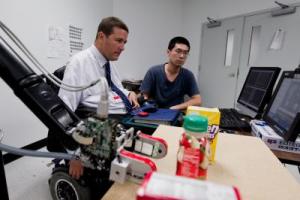Sep 24 2010
One touch directs a robotic arm to grab objects in a new computer program designed to give people in wheelchairs more independence.
University of Central Florida researchers thought the ease of the using the program's automatic mode would be a huge hit. But they were wrong – many participants in a pilot study didn't like it because it was "too easy."
 Bob Melia, a quadriplegic who advised the UCF team, says the new technology will make life easier for thousands of people who are so dependent on others because of physical limitations.
Bob Melia, a quadriplegic who advised the UCF team, says the new technology will make life easier for thousands of people who are so dependent on others because of physical limitations.
Most participants preferred the manual mode, which requires them to think several steps ahead and either physically type in instructions or verbally direct the arm with a series of precise commands. They favored the manual mode even though they did not perform tasks as well with it.
"We focused so much on getting the technology right," said Assistant Professor Aman Behal. "We didn't expect this."
John Bricout, Behal's collaborator and the associate dean for Research and Community Outreach at the University of Texas at Arlington School of Social Work, said the study demonstrates how people want to be engaged -- but not overwhelmed -- by technology. The psychology theory of Flow describes this need to have a balance between challenge and capacity in life.
"If we're too challenged, we get angry and frustrated. But if we aren't challenged enough, we get bored," said Bricout, who has conducted extensive research on adapting technology for users with disabilities. "We all experience that. People with disabilities are no different."
The computer program is based on how the human eye sees. A touch screen, computer mouse, joystick or voice command sends the arm into action. Then sensors mounted on the arm see an object, gather information and relay it to the computer, which completes the calculations necessary to move the arm and retrieve the object.
Behal is seeking grants to translate the study's findings into a smoother "hybrid" mode that is more interactive and challenging for users and features a more accurate robotic arm. Laser, ultrasound and infrared technology coupled with an adaptive interface will help him achieve his goals.
The key is to design technology that can be individualized with ease, Behal said. Some patients will have more mobility than others, and they may prefer a design closer to the manual mode. Though the automatic mode wasn't popular in the pilot study, it may be the best option for patients with more advanced disease and less mobility.
Bob Melia, a quadriplegic who advised the UCF team, says the new technology will make life easier for thousands of people who are so dependent on others because of physical limitations.
"You have no idea what it is like to want to do something as simple as scratching your nose and have to rely on someone else to do it for you," Melia said. "I see this device as someday giving people more freedom to do a lot more things, from getting their own bowl of cereal in the morning to scratching their nose anytime they want."
Source: http://www.ucf.edu/